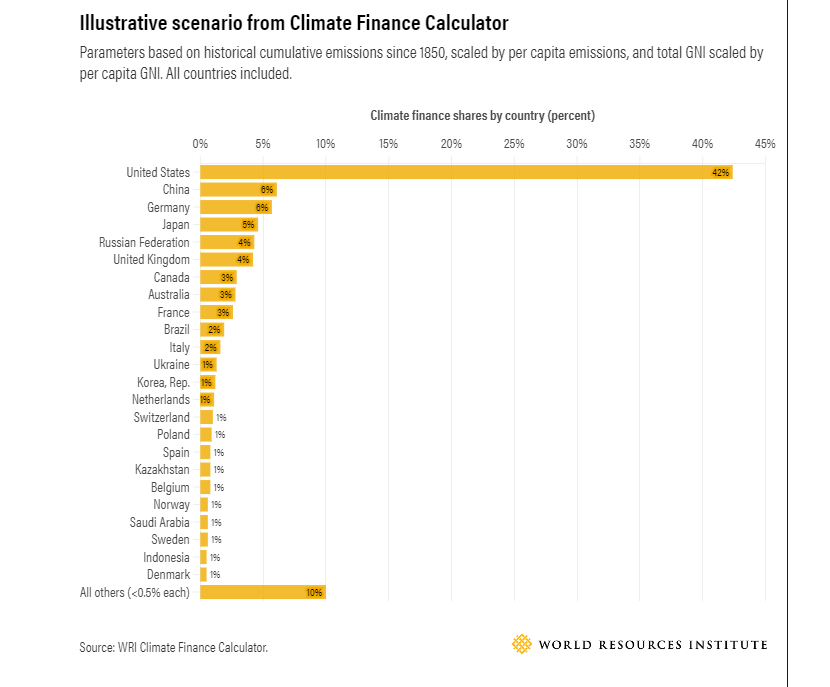UNCTAD’s “Trade and Development Report 2023” says an estimated $4 trillion must be mobilized yearly to fight climate change and achieve the Sustainable Development Goals (SDGs).
Although this figure appears massive, it represents just 1% of the total global financial assets, currently valued at over $470 trillion.
“But it’s not easy to shift resources away from long-standing and often profitable activities,” says Anastasia Nesvetailova, head of UNCTAD’s macroeconomic and development policies branch. She adds that channelling resources to new or less certain investments is always challenging (Trillion-dollar shift, 2024).
The report also highlights that eight years after the Paris Agreement, finance for fossil fuels—which climate scientists blame for causing climate change—continues to grow at more than $1 trillion annually.
In 2009, developed countries agreed to raise $100 billion annually to support developing countries’ climate action, such as climate adaptation and mitigation or shifting away from fossil fuels to cleaner energy and economies. The OECD states that it was only in 2022 that developing countries met the goal of mobilising $100 billion.
Fifteen years after establishing the $100 billion goal, negotiators are already busy setting up a new finance goal, a “new collective quantified goal on climate finance” (NCQG) to replace the $100 billion per year goal and meant to be adopted this year at COP29 in Azerbaijan, the WRI reports.
NCQG will channel funds to urgently needed climate action in developing countries and support the implementation of low-carbon, climate-resilient solutions in energy, transport, agriculture and other vital systems.
The increased financial support also aims to help developing countries step up their climate ambitions in the next round of their nationally determined contributions (NDCs), which embody efforts by each country to reduce national emissions and adapt to the impacts of climate change. The NDCs are due in 2025.
Who will pay and how much?
According to the WRI article, to date, countries on the UNFCCC Annex II list, composed of 23 mostly high-income countries designated by the Convention as responsible parties for paying the costs for developing countries and providing financial resources to achieve lower emissions and greater climate adaptation and resilience.
However, 30 years after the Annex II list was created, so much has changed—the world’s per capita income has tripled, and living standards have improved. Some of these have happened in countries outside of the Annex II list, and these countries not only have more wealth but also higher emissions. That is why Annex II countries like the US, Germany, Japan, Australia, New Zealand, and Canada are now pushing for some of them to contribute.
However, how much these countries should contribute and what factors need to be considered in calculating their share of contributions – levels of historical and recent emissions, levels of wealth, and capacity to pay- will be the subjects for debate.
WRI has created a climate finance calculator that generates scenarios based on a country’s historical emissions and income level. Evaluating different scenarios highlights the nuances needed to consider the level of responsibility for different countries.
The climate finance calculator allows users to create scenarios based on various economic and emission factors to determine how much countries should contribute or the percentage of their share in the climate finance goal.
Creating a scenario allows the user to choose what countries to include based on their grouping (UNFCCC Annex II, high income, OECD, etc.), emissions indicators (historical, more recent, and per capita), a country’s capacity to pay based on their Gross National Income (GNI).
According to the WRI, almost every scenario using all the combinations of emissions and economic metrics always results in the United States coming on top as having the largest share in climate finance contribution, with the second place coming at a far distance.
This is because the U.S. has the highest cumulative GHG emissions since the 1850s, remains the second-highest emitter annually, and has the biggest economy in the world with a high per capita income and high emissions levels.

The article highlights other considerations and factors to ensure fairness and transparency among all countries when determining their share in climate finance.
These factors include economic development and how long they have enjoyed this, climate vulnerability, and levels of emissions and wealth. For instance, some countries are not Annex II but have high emissions and high incomes and need to contribute.
Considering that all the metrics in the climate finance calculator may not be enough on their own, they can help assess and promote fairness in determining countries’ share in the climate finance goal, which also reflects their contributions to the climate change crisis.
Source:
Trillion-dollar shift urgently needed to align global finance with climate and development goals. (2024, March 6). UN Trade & Development. Retrieved from https://unctad.org/news/trillion-dollar-shift-urgently-needed-align-global-finance-climate-and-development-goals.
Zou, C., Alayza, N., Higgins, H., & Larsen, G. (2024, September 17). Which Countries Should Pay for International Climate Finance? WRI. Retrieved from https://www.wri.org/insights/international-climate-finance-which-countries-should-pay?
Alayza, N., Larsen, G., & Waskow, D. (2024, May 29). What Could the New Climate Finance Goal Look Like? 7 Elements Under Negotiation. WRI. Retrieved from https://www.wri.org/insights/ncqg-key-elements
Climate Finance Calculator. (2024, September 17). WRI. Retrieved from https://www.wri.org/data/climate-finance-calculator



Leave a Reply